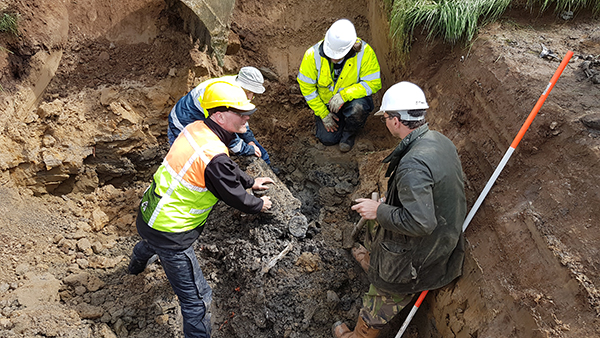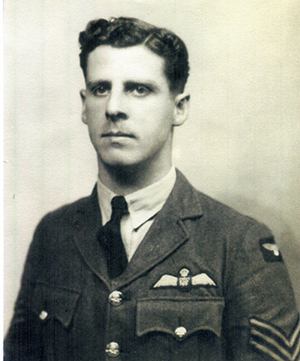The Monaghan Spitfire—Life on the Border with a World at War
Published in Issue 4 (July/August 2018), News, Volume 26Just after 11am on 20 September 1942, the quiet Sunday stillness of the Emyvale countryside in north County Monaghan was shattered by the screaming roar of a Spitfire as it dived down, unmanned, from the clouds. Meanwhile, just over the border in Northern Ireland, its Royal Air Force pilot descended safely under his parachute while listening to the last fitful cries of his stricken fighter. Minutes later, it plunged into a field just over the southern side of the border in County Monaghan and exploded. Its time in the war-torn skies of Britain and Ireland was over, but the epic story of the Monaghan Spitfire and the world in which it had fought remained to be told.
This summer, Monaghan County Museum presents an explosive new exhibition: The Monaghan Spitfire—Life on the Border with a World at War. This incendiary display, which has been developed in partnership with numerous organisations from both North and South, including the Royal Air Force, Queen’s University Belfast and the Irish Air Corps, and with input from the Imperial War Museum, London, explores the deadly experience of a county on the border between two worlds: one tearing itself apart and another trying desperately to stay out of a global conflict that had almost engulfed it. Using never-before-seen artefacts and images, as well as chilling first-hand accounts, this enthralling exhibition takes the viewer on an exciting journey through life and death in the region during the turbulent years of the Second World War.
The Monaghan Spitfire crash site was excavated in 2017 by a cross-border group that included Monaghan County Museum, the RAF Benevolent Fund, Queen’s University and students from secondary schools, North and South. Among the finds from the dig is the Spitfire’s famous Merlin Rolls Royce engine, which forms the core of the exhibit. The Monaghan Spitfire is the only one of its kind ever found in the South that had been involved in the famous Battle of Britain.

Above: The scene at the excavation in 2017, when the Merlin Rolls Royce engine from the Monaghan Spitfire was discovered. (Monaghan County Museum)
A number of objects have also been recreated, such as a life-size replica of the 500kg German bomb that was dropped on Monaghan in 1940. Thankfully no one was killed, but the bomb caused an enormous amount of damage. At almost 7ft high, the scale of this enormous explosive device offers visitors a very real and immediate insight into the death and destruction raining from the skies during this violent time. After the fall of France in 1940, Nazi Germany turned its sights on Britain, and the Monaghan Spitfire was involved in a number of engagements during that desperate last stand known as the Battle of Britain. Had Germany been successful in invading Britain, it had developed a plan of invasion for Ireland, codenamed ‘Operation Green’. An original set of these German invasion plans also features, the first time that the chilling documents have ever been on public display.

Above: Flight Lt. Gordon Proctor, the pilot of the Spitfire, who mercifully survived the crash. (Proctor family)
The exhibition is brought to life through the personal stories of a number of those involved, including:
- Flight Lt. Gordon Proctor, the pilot of the spitfire, who mercifully survived the crash, though shortly thereafter was declared missing in action. Flight Lt Proctor’s family has loaned several original documents relating to his illustrious military career.
- Emyvale local Josie McCusker, who was a schoolgirl at the time of the crash, provides a fascinating first-hand eyewitness account of the event via video.
- The tragic story of Scottish Sgt John Reid McMillan, who lost his life in a crash in Knockatallon, north Monaghan, the following year.
- William ‘Timber’ Woods from nearby Carrickmacross, who was sadly sent to his death fighting the Germans in Greece.
- Monaghan nurse Mary Cooper, who died aged 27 in a prisoner-of-war camp in Sumatra.
The museum is working with renowned film-maker Luke Leslie to produce a number of short films that will feature as part of the display, chronicling how the war did not recognise or respect the neutrality of County Monaghan and instead crashed and exploded into the county on a number of occasions during that global conflict. One of the short films will focus on the Monaghan Spitfire, including first-hand accounts of the crash, the immediate aftermath and the lasting scar it left on the physical and social landscape of the area. Another will investigate the untold story of the German bombing in the townland of Bocks Upper in the south-west of the county during the winter of 1940. Two enormous 500kg bombs were dropped on the quiet hamlet on a cold December evening. Why were they dropped? Was it an accident? An attack? Or a warning to stay out of the war?
The Monaghan Spitfire exhibition opened on 28 June 2018 in the County Museum, 1–2 Hill Street, Monaghan, and will run for at least twelve months. For further details, see www.monaghan.ie/museum or visit the Monaghan County Museum Facebook page.
















